JUMP CUT
A
REVIEW OF CONTEMPORARY MEDIA
![]()

Hero is as much a film about the standardization of the Chinese written script or language as it is about the unification of China.


House of Flying Daggers is a good example of trans-national, trans-regional collaboration in the film industries of Greater China: involving actors from China, Taiwain, Hong Kong.


It is wryly humorous to hear their Cantonese accents as the superstars from Hong Kong speak dignified Madarin in the setting of ancient China in "Hero."


In Crouching Tiger Michelle Yeoh’s character, against all probability, speaks Hong Kongese-inflected Mandarin.


Crouching Tiger mixes the Hong Kong-style Mandarin of Chow Yun-fat and Michelle Yeoh with the impeccable Mandarin of the mainlander Zhang Ziyi.


In Hero Jet Li in the role of Wu Ming, the assassin, is persuaded by the King of Qin’s rhetoric of a great Chinese empire and gives up his mission.

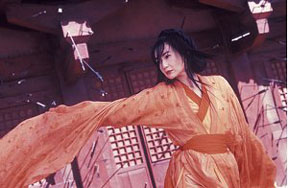
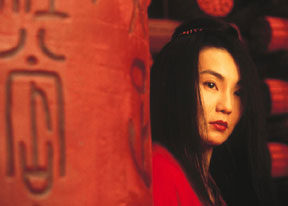
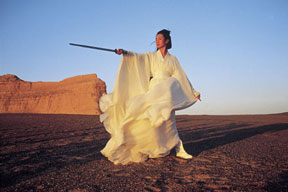
In Hero, Zhang Ziyi, Maggie Cheung, and Tony Leung battle out their martial arts skills, wit, and love in masterfully choreographed action scenes.

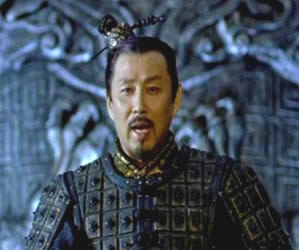
Hero: Chen Daoming, as King of Qin. The future First Emperor propagates a Great-China ideology.


Andy Lau has a mesmerizing star presence in House of Flying Daggers

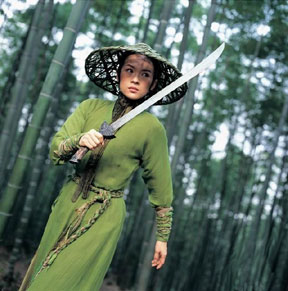
The Zhang Ziyi character, Xiaomei, is a member of the secret society “House of Flying Daggers” (feidao men).




House of Flying Daggers: Whispers of love in a story about a deadly love triangle in the Tang Dynasty.


Story of Qiu Ju: Gong Li learned how to speak the Baoji dialect in order to deliver a convincing performance of a peasant woman.

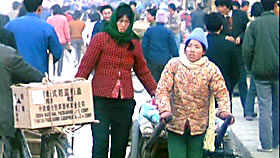
Story of Qiu Ju: Documentary realism in a contemporary market-place in Shaanxi Province.
World of dancing martial arts heroes
Now I would like to examine how language functions in another kind of Chinese films, i.e., Zhang Yimou’s commercial blockbusters Hero (Yingxiong 2002) and House of Flying Daggers (Shimian maifu, 2004). In these films, only standard Mandarin is used. “All under heaven” (tianxia), these heroes speak a universal putonghua. Their combats and showdowns appear more like well-choreographed dance sequences than actual fighting. Special effects enhance the quality of improbable feats of martial arts. Indeed, in the beginning of House of Flying Daggers, the Zhang Ziyi character, Xiaomei, a member of a secret society, pretends to be a blind dancer, showcasing an extraordinary, putatively Tang dynasty-style dance in a pleasure quarter.
The characters of the films come from northern China — especially Zhang’s home province, Shaanxi. Hero is set in the Qin (modern Shaanxi Province). House of Flying Daggers is set in the Tang Dynasty, and the locale of action is in Feng Tian County, near the capital city Chang’an, or modern Xi’an, Shaanxi Province. But the Mandarin spoken by some of Zhang’s larger-than-life, ancient heroes and martial arts experts is slightly accented Mandarin. However slight their accents are, the speeches of Tony Leung, Maggie Cheung, and Andy Lau do not sound like the kind of elegant Mandarin delivered by mainland Chinese actors and actresses in traditional films and historical dramas. Chinese drama and film academies have trained their actors to speak and act in certain appropriately “dramatic” fashions. The situation is perhaps not unlike the difference between British actors trained in the Royal Shakespeare Company to a U.S. college production of a Shakespeare play. It is the same play, but vastly different in speech expression, delivery, and convention.[7] [open notes in new window] It appears that the Mandarin spoken by these most highly paid megastars from Hong Kong lacks the lyricism and eloquence that audiences in Mainland China and Taiwan expect.
But director Zhang Yimou has the entire Asian and world market in mind, and he uses stardom to appeal to global audiences. He is looking at the example of worldwide commercial success of Crouching Tiger Hidden Dragon, which is notorious for its Cantonese-accented speeches by the lead actors (Chow Yun-fat and Michelle Yeoh). The dialectal implausibility does not affect the warm international reception of Ang Lee’s film. The audiences do not understand any Chinese dialect anyway and rely on subtitled English translation, which in itself is full of classical lyricism. Therefore, it does not matter if Zhang Yimou’s cast of superstars delivers Mandarin lines with small local accents in his martial arts films. What matters is that the presence of these stars from Greater China would guarantee box office success.
Maggie Cheung and Tony Leung in Hero and Andy Lau (Captain Liu) in House of Flying Daggers speak a Cantonese-tinged Mandarin, and Jin Chengwu (Kaneshiro Takeshi, Captain Jin) in House of Flying Daggers speaks in the style of Taiwanese-Mandarin (Taiwan guoyu). It is the farthest from the truth to say that only speakers of perfect Mandarin lived in ancient China. The fact of the matter is that the audience’s linguistic expectations have been conditioned by what they have watched on screen and TV. Television series and historical dramas produced in mainland China and Taiwan have been watched by people in Hong Kong, Taiwan, and the diaspora. They set the standards for what appears to be authentic historical events and plausible historical characters. Mainland Chinese actors such as Chen Daoming in Hero and Zhang Ziyi in House of Flying Daggers thus appear to be more believable characters and steal the show. The First Emperor speaks in the mouth of the Beijing-trained actor Chen Daoming, and expounds the virtues of creating a grand Chinese empire, a globalized Chinese world — tianxia.
Hero is also a story abut the Chinese language, the Chinese written script, and Chinese calligraphy. When the assassin Wuming (literally “Nameless,” Jet Li) tells the Emperor that there are nineteen ways of writing the word jian (sword), the Emperor retorts that in his future unified world there will not be the confusion of so many ways of writing one word, but there will be only one way of writing it. In fact, the historical First Emperor was the person who unified the Chinese language. He ordered all the former feudal states to adopt the Qin zhuan script (zhuanti) as the standard Chinese script. The nationalist ideology of the film might be lost to world audiences, to non-China specialists unfamiliar with intra- and inter-Chinese politics as they are engrossed by the beautiful cinematography, fantastic choreography of action, and neo-orientalist spectacles. Zhang’s film has faint echoes of the real historical story of Jing Ke’s attempted assassination of the First Emperor as recorded in historical records, but the details are largely fictional. Jing Ke does attempt to kill the First Emperor at the Qin court, but Wuming backs down from his original plan, becomes a follower of the Emperor’s Great China ideology, and willingly sacrifices his life for the sake of national unity.[8]
With the ambition to capture the global box office, it does not matter if Mandarin sounds impure or inauthentic to the ears of Chinese-language speakers. What matters to Feng Xiaogang matters less to Zhang Yimou. Dialectal authenticity is important for the effect of fictional realism in Feng’s films. As we know, Feng’s films are extremely popular in mainland China, but do not circulate in the movie theaters of the world. But Zhang Yimou aims at creating a pan-Chinese, pan-Mandarin world in the Greater China area for his films to freely circulate. Linguistic authenticity is not an issue in the targeted international market.
Furthermore, the desired effect is the creation of a breed of supranational Chinese films to be watched and enjoyed by global audiences. The Zhang Yimou of pan-Chinese martial arts has come a long way from the early Zhang who diligently explores contemporary social problems of mainland China. For example, in The Story of Qiu Ju (1993), dialectal authenticity is crucial to his film aesthetics. Gong Li and other actors must learn how to speak proper Shaanxi dialect in order to faithfully portray their characters. More specifically, the Shaanxi dialect used in the film is no ordinary Shaanxi dialect, but the dialect of Baoji, “a crossroads of migrants from Sichuan, Gansu, and Ningxia.” As Edward Gunn reminds us,
“Like Zhongjiang and Wanxian in the comedy of Chengdu and Chongqing, or Subei in the comedy of Shanghai, the residents of Baoji were ridiculed in Xi’an as the stereotype of quaint, slow-witted boors.”[9]
The Baoji dialect sounds even more rustic and local than some other dialects of Shaanxi. But that kind of linguistic and atmospheric realism is no longer a consideration in Zhang’s new films whose success is built on fabricating unreal yet aesthetically pleasing scenes and actions. The Story of Qiu Ju, Hero, and House of Flying Daggers are all set in present-day Shaanxi Province, Zhang’s homeland and pride, and his favorite locale of action. But his strategy of filmic representation has changed.
Sinophone cinema?
Evidently, we are looking at examples of Chinese-language films in which dialects serve different functions. They may address the domestic audience of mainland China (Feng Xiaogang’s films), or resonate with the tastes and aspirations of a local audience (The Dance Age), or spill over national boundaries and target global audiences and markets (Zhang Yimou’s films). The Minnan dialect in The Dance Age establishes a Taiwanese modernity distinct from that of guoyu-speaking mainstream mainland culture, a modernity which could be local or national, depending on one’s political persuasion. Local and provincial dialects in The World, A World without Thieves, and Cell Phone are not about the provinces per se, but are emblematic of larger national predicaments in China’s modernization efforts. The bland, ubiquitous putonghua in Zhang Yimou’s martial arts films does not enhance the building of a credible regional flavor and an ambience of cinematic verisimilitude. These films sell themselves out to pan-Chinese audiences in the Greater China as well as to non-Chinese spectators around the globe where the issue of Chinese language is irrelevant.[10] In a state of polyglossia, dialects in such diverse films constitute subjectivities at not only the national, but also the subnational and supranational levels. In the analysis of dialectal aesthetics, the model of national cinema can only cover part of the problem at hand. The “transnational” is better suited to track the flows and circulations of film culture beyond the limits of the nation-state.
We may explore these multi-dialectal phenomena in yet another direction by looking into the problematic of what we may call “Sinophone cinema.”[11] Naturally, Chinese-language cinema calls for a comparative study of parallel cinematic traditions where language transcends the territorial boundaries of nation-states, such as German-language cinema, Francophone cinema, and Anglophone cinema. Not unlike these traditions, Chinese-language films express the claims and convictions of diverse communities with varied cultural, political, and dialectal backgrounds, albeit all under the loose rubric of “Chinese-language speakers.”[12]
“Huayu dianying,” “Chinese-language cinema,” and “Sinophone cinema” seem to be equivalent terms denoting a same field of cultural production and a same analytic framework. But the connotations of these terms may diverge as well as overlap. To use Sinophone cinema to describe our field is to open up a new range of issues. Can we speak about Sinophone cinema in the same way we talk about Anglophone cinema and Francophone cinema? Colonialism, mimicry, decolonization, national independence, identity politics, and postcoloniality often define the perimeters and themes of these cinematic traditions. Obviously, China was subject to colonization historically, and it also acted like a colonial-imperial power to its periphery. Hong Kong, Macau, Taiwan, and parts of mainland China became colonies or were granted the status of extraterritoriality. The aftermath of the colonial legacies continues to be felt today. In cinematic production, the use of dialects indicates such historical and present divisions within the Chinese body politic and mindset.
We may float the idea of “Sinophone cinema” in order to draw certain preliminary comparisons and contrasts with related situations in world film. In the anthology World Cinema: Critical Approaches, the cinemas of Britain, Ireland, Australia, and Canada are listed and studied under the category of “Anglophone national cinemas.”[13] Hollywood, an Anglophone yet global cinema, is too large and international to be subsumed under “national cinema.” Francophone cinema refers to the films of Francophonie or Francophonia, namely, the former French colonies outside the sovereignty of France. Although France hopes to assert its influence on these countries by promoting the notion of Francophonie, post-independent Francophone Africa is steadily moving away from France’s cultural and linguistic hegemony by asserting its own indigenous traditions and idioms. Nevertheless, African filmmakers sometimes strategically identify themselves with the Francophone world for a wider distribution of their films.
“Despite the increasing use of Arabic and local languages throughout the African continent, reference to Francophone African cinema continues to be valid; it views African cinema in its historical context and is a means of promoting the films of these individual countries more strongly. It also provides a counter-balance against an increasing incursion of Anglophone cinema.”[14]
In the terrain of Francophone cinema, there are the simultaneous movements of extending the neocolonial cultural influence on the part of France and of the resurgence of indigenous cultures in postcolonial African states. Resistance and self-affirmation in postcolonial African cinema nevertheless operate within and take advantage of the larger Francophone network of production, funding, and distribution. Yet, between the francophone and the postcolonial, there are further important distinctions.
“Unlike francophonie, the political dimensions of which are masked by a term which superficially appears to denote a purely cultural field of reference, the post-colonial highlights a political condition characterizing certain forms of cultural production, i.e. the legacy of colonial domination out of or against which cultural practices are seen to emerge.”[15]
Greater China is not necessarily a monolithic, colonial, oppressive geopolitical entity, or an intrinsically conservative concept. Neither is Sinophone cultural production from the margins an inherently postcolonial, counter-hegemonic discourse. A film's political and cultural impact depends on specific conjectures of forces and circumstances. It might be useful to revisit the old problematic of colonial/postcolonial in the context of our present state of existence, namely, a new wave of globalization that has intensified in the post-cold war era. Transnational, border-crossing Sinophone cinema goes hand in hand with globalization and is its epiphenomenon. Chinese-language films address audiences beyond the Chinese nation-state, engage citizens of Taiwan, Hong Kong, Macau, spread to the Chinese diaspora, and reach interested spectators anywhere in the world. Sinophone cinema thus takes a more flexible position in regard to national identity and cultural affiliation.
There is no one dominant voice in the field. The multiple tongues and dialects used in varieties of Sinophone cinema testify to the fracturing of China and Chineseness. Each dialect-speaker is the voice of a special class, represents a particular stage of socio-economic development, and embodies a specific level of modernity within a messy ensemble of heterogeneous formations in China and the Chinese diaspora. This profusion of accents in fact comprises a pan-Chinese world — a collective of diverse identities and positionalities that a single geopolitical, national entity is unable to contain. Shijie or tianxia is not a monologic world speaking one universal language. The world of Sinophone cinema is a field of multilingual, multi-dialectal articulations that constantly challenge and re-define the boundaries of groups, ethnicities, and national affiliations.
To
top![]() Print
version
Print
version![]() JC 49
JC 49 ![]() Jump
Cut home
Jump
Cut home

This work is licensed under a Creative Commons Attribution-NonCommercial-NoDerivs 2.5 License.